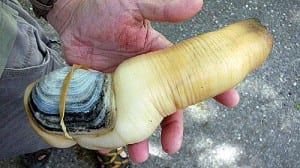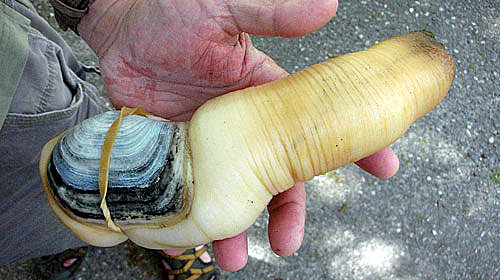 Southeast Alaska dive fishermen are nearly done with their harvest of geoduck clams.
Southeast Alaska dive fishermen are nearly done with their harvest of geoduck clams.
Geoduck clams are huge. In fact, they are the largest burrowing clams that exist, averaging two and a half pounds each. And if you’ve never seen one, they are a bit phallic too. None the less, these clams are sought in international markets.
Justin Breese is the Assistant Area Management Biologist for Commercial Fisheries in Ketchikan.
“Probably the majority of geoducks harvested in the Southeast Alaska fishery are harvested and shipped out live in the international markets,” Breese says.
You won’t find many geoduck shells on the beach. They tend to be out in deeper water. Commercial divers might seek the crabs out around 30 feet or so. Breese says fishermen look for geoduck beds where several of the clams are gathered.
“On average, you’re diving in about 30 feet of water so between 30 and 60 feet of water,” Breese says.
Each week this month, divers have had two, 6-hour days to harvest the clams.
The season started October 1 with an overall Guideline Harvest Level for the Ketchikan area of 750,700 pounds. Of that, about 40,000 pounds are left for fishermen to harvest.
16 areas were open this season and only two of those remain open.
The geoduck fishery is a smaller fishery with just 60 permit holders participating. However, it can be a lucrative venture as prices in the past have reached $20 a pound. The average price is around $10 a pound but this season it’s been below the average at about $6.
Unlike some of the other larger fisheries like the seine and gillnet fisheries, geoduck fishermen are involved with the management details. Before the season starts the fishermen choose the days of the week for openings. They also help work out the details of testing the clams for PSP or Paralytic Shellfish Poison which can be fatal to humans.
“They have worked out their own sampling program with the Department of Environmental Conservation that is approved by the FDA and they have to be tested like that so they can be shipped out live,” Breese says, “and so it’s a pretty involved process to have a fishery.”
The geoduck fishery is one of the three commercial dive fisheries in Southeast Alaska. Divers also go after sea cucumbers and sea urchins. Breese says both the sea urchin and geoduck fisheries are feeling the effects of sea otter predation.










